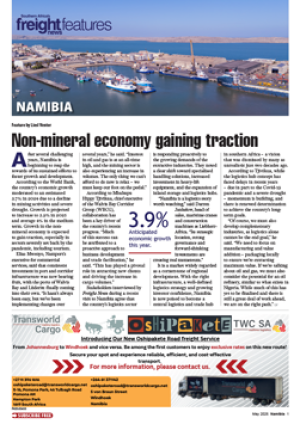FTW founder John Marsh
decided to start a freight
and container publication
in 1973 when shipping lines
and ports started planning for a
switchover to containerisation four
years later.
According to the World
Shipping Council, the birth of
containerisation was on April 26,
1956, when Malcolm McLean’s
converted World War II tanker, the
Ideal X, made its maiden voyage
from Port Newark to Houston in
the USA.
It had a reinforced deck carrying
58 metal container boxes as well as
15 000 tons of bulk petroleum.
By the time the container ship
docked at the Port of Houston six
days later the company was already
taking orders to ship goods back
to Port Newark in containers.
McLean’s enterprise later became
known as Sea-Land Services, a
company whose ships carried
cargo-laden truck trailers between
northern and southern ports in the
USA.
We reported on the introduction
of containerisation to South Africa
late in 1975 with the building of
container terminals in the main
ports, as well as in Johannesburg
(City Deep).
This was one of the first dry ports
in Africa.
July 11, 1977, is remembered
in the industry as “C-Day” as
it marked the official start of
containerisation on the South
African ocean trade. Safmarine
vessels SA Morgenster and SA
Constantia inaugurated the Cape
Town and Durban container
terminals on the day.
Safmarine’s first cellular
containership, the SA Langeberg,
arrived in Cape Town on August
23, 1977 on her maiden voyage.
A year later, the first of the
four “Big Whites,” the 2420-TEU
SA Helderberg docked in Cape
Town on her maiden voyage
under the command of
Commodore Robin Thomson.
At a global level, the expansion
of containerisation both facilitated
and was driven by the removal of
trade barriers in the 1990s.
In May 2002 the AP
Møller Group, which had taken
over Safmarine in 1999, sold the
Big Whites to Monaco-based MC
Shipping and promptly chartered
them back on a bare-boat basis.
The vessels – SA Helderberg,
SA Winterberg, SA Sederberg
and SA Waterberg (later Maersk
Constantia) – were finally taken out
of service in 2007/2008.
The 1990s saw the introduction
of Post-Panamax vessels capable
of carrying up to 5 000-TEUs,
followed by the fifth generation of
8 000-TEU vessels up to 2005, and
today’s 18 000-TEU giants.
As of writing, the largest vessel
handled in South African ports was
the 11 660-TEU MSC Sola, which
called on Durban and Ngqura in
July this year.
Containerisation continues apace
with the newest commodities being
reefer cargo and ore.
The containerised share of
seaborne reefer shipments is
expected to reach the 70% mark by
2015, according to Safmarine.
With upgrades of ship-toshore
cranes, gantries and other
equipment in most South African
ports – and those of our neighbours
and other countries in Africa –
the challenge now is to take full
advantage of the intermodal
capabilities of containers.
At present it is cheaper to destuff
containers at the port and transport
the contents as road break bulk
rather than keep the container
safely locked until it reaches its
destination.
Shipping companies have
responded by opening their own
offices in land-locked countries
in order to retain control of their
containers.
But Africa will only enjoy the
full benefits of containerisation
once the rail infrastructure is
fully operational.
CAPTION
The 11660-TEU MSC Sola ... largest ship yet to dock at an SA port.

